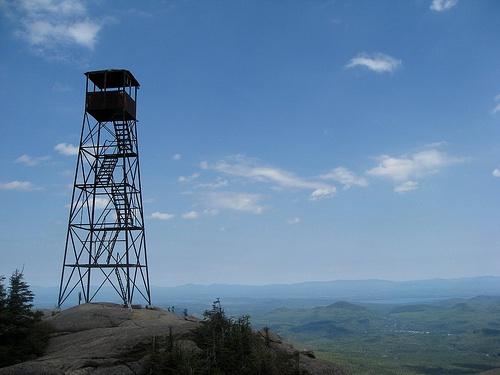Nearby The Wild Center
The Wild Center is located in Tupper Lake. There are numerous lakes and rivers nearby, including nine-mile long Tupper Lake and the Raquette river that runs by the Center’s campus. The town of Tupper Lake has a distinct history of pioneers, loggers, and Adirondack sportsmen. The railway arrived in Tupper in the 1890’s and much of the modern town was built in the boom years that followed. Tupper was the lumber capital of New York in the early 1900’s. You can see the huge site of the giant mill down by the lake shore. Today the site is a public park, and home to local events, including the annual Woodsmen Field Days festival where lumberjack skills are on display every July.
Local food and drink are abundant in Tupper Lake so don’t forget to pick up some fresh donuts or a take-home growler on your way out of town.
Local food and drink are abundant in Tupper Lake so don’t forget to pick up some fresh donuts or a take-home growler on your way out of town.

Mt Arab retains its special attraction. It’s an old but still usable Fire Tower that is its top attraction. The view is great, and there is something about being on top of a peak and then climbing stairs to be even more above it all that makes this a special place to climb. The hike is short, around a mile each way. This tower was first erected in 1918. Towers were like lighthouses, and the keepers, called observers, lived nearby, and were on the summits to warn of smoke. In the second world war they also reported plane traffic.
Remember how forests looked to the Brothers Grimm? Trails wove around the feet of towering trees that looked like the columns of a living vaulted cathedral. That’s this forest, with some trees that have seen 500 winters. Go back. Manhattan is a hilly forested island with perhaps a column of smoke rising from a Wappinger’s fire. The Adirondack mountains are rarely visited by humans. Around these young trees the only stories were those of wolves, lions, bear, birds and fish. The scraping sounds of a boat pulling ashore at Plymouth Rock never reached them here.
It’s a little amazing that you can park your car and walk five minutes and be in that place, and that’s why Ampersand Forest is on The Wild Center’s 46 Wonders. These trees reach from another time into ours, and people say they feel something different when they walk in their shade.
It’s a little amazing that you can park your car and walk five minutes and be in that place, and that’s why Ampersand Forest is on The Wild Center’s 46 Wonders. These trees reach from another time into ours, and people say they feel something different when they walk in their shade.
What to Look for in Ampersand Forest
There are old maples, hemlocks and yellow birch trees. For figuring their ages, a hemlock 18 inches across is around 250 years old. If you can reach your adult arms half way around a maple it is in the 400 plus range.
Ampersand Brook will be on your right as you walk in. Its rocks and boulders are covered in mosses. Because this stream flows through so much undisturbed land it is often studied. People who want to understand how the life of a stream that made its own way for thousands of years differs from streams that have seen more manmade changes on their banks come here to count and measure.
Map ItAmpersand Brook will be on your right as you walk in. Its rocks and boulders are covered in mosses. Because this stream flows through so much undisturbed land it is often studied. People who want to understand how the life of a stream that made its own way for thousands of years differs from streams that have seen more manmade changes on their banks come here to count and measure.
The prevailing winds have blown up one of the longest sandy beaches in the Adirondacks on this shore of Middle Saranac Lake. It’s an easy walk from the same parking lot you use to access Ampersand Forest and Mountain.
Most beaches around here are not much more than the sandy outwash of a cold brook running into a lake. This one is different. It goes on and on, and it’s a great place to wade far out into the water. You can walk 100 yards into the lake and still have your feet on the ground.
Most beaches around here are not much more than the sandy outwash of a cold brook running into a lake. This one is different. It goes on and on, and it’s a great place to wade far out into the water. You can walk 100 yards into the lake and still have your feet on the ground.
What to Look for at Middle Saranac Beach
Look for the secret picnic table. You need to walk along the beach until you find a brook feeding into the lake. Turn upstream and you’ll find a nice place to set out a meal in the shade of the pines. You can also look for freshwater mussels, but you look with your toes, wiggling them to sink into the sand and mush until you feel one. You can sometimes see piles of shells where raccoons, otters and muskrats have left their after-dinner shell collections.
This native jewel-like fish’s family arrived here by swimming up the icy waters crashing down from melting glaciers 10,000 years ago. They still favor the cold water of streams, and you usually find them far up in the smaller waters where the newer immigrant fish can’t out-compete them.
Little Tupper Lake was one place the bucket brigade never reached because it was long in private hands. The Lake today harbors one of the few remaining native strains, and you can paddle over their domain. It’s very rare to have a lake still bejewelled by these fish. People continue to work hard to keep imported fish out of this lake so the brook trout that once ruled the waters of the Adirondacks have a place where they are still king.
Why is this a wonder? It’s our special fish for one, and it is actually in the middle of a step of evolution. As the ice left the region, the water levels went down, and waters that once ran together were divided into disconnected ponds and lakes. The fish were divided too. Separated from their kind, the trout in many lakes began to evolve differently. The Little Tupper Brook Trout are now different from other local brookies, and the only ones of their kind on Earth.
This native jewel-like fish’s family arrived here by swimming up the icy waters crashing down from melting glaciers 10,000 years ago. They still favor the cold water of streams, and you usually find them far up in the smaller waters where the newer immigrant fish can’t out-compete them.
Little Tupper Lake was one place the bucket brigade never reached because it was long in private hands. The Lake today harbors one of the few remaining native strains, and you can paddle over their domain. It’s very rare to have a lake still bejewelled by these fish. People continue to work hard to keep imported fish out of this lake so the brook trout that once ruled the waters of the Adirondacks have a place where they are still king.
Why is this a wonder? It’s our special fish for one, and it is actually in the middle of a step of evolution. As the ice left the region, the water levels went down, and waters that once ran together were divided into disconnected ponds and lakes. The fish were divided too. Separated from their kind, the trout in many lakes began to evolve differently. The Little Tupper Brook Trout are now different from other local brookies, and the only ones of their kind on Earth.
Here are some nearby cultural Institutions and places to see:
- Adirondack Experience
- Adirondack Public Observatory
- Akwesasne Cultural Center Museum & Library
- Ausable Chasm
- Fort Ticonderoga
- Great Adirondack Corn Maze
- Great Camp Sagamore
- Raquette Lake Navigation
- High Falls Gorge
- Lake Placid Olympic Sites Passport
- Native North American Travelling College
- Natural Stone Bridge and Caves
- Santa’s Workshop, North Pole, NY
- Six Nations Iroquois Cultural Center
- Whiteface Memorial Highway
